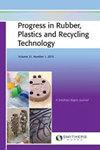Comparative evaluation of oil resistance, dielectric properties, AC conductivity, and transport properties of nitrile rubber and chlorinated nitrile rubber
IF 1.6
4区 材料科学
Q4 MATERIALS SCIENCE, COMPOSITES
Progress in Rubber Plastics and Recycling Technology
Pub Date : 2020-05-20
DOI:10.1177/1477760620925490
引用次数: 15
Abstract
Nitrile rubber (NBR) has been extensively used in high oil resistance application such as in automotive seals and gaskets. Due to the poor mechanical strength of NBR, the performance of these products undergoes deterioration when it is in contact with hot oils and solvents. The aim of the present work is to investigate the molecular transport of petroleum fuels and oil through chlorinated NBR (Cl-NBR) with respect to different contents of chlorine. It also focuses on the effect of chlorine content on the alternating current (AC) conductivity and dielectric properties of Cl-NBR for flexible electronic applications. The transport characteristics of petroleum fuels through the NBR and Cl-NBR membranes have been studied by a simple sorption gravimetric analysis in the temperature range 27–50°C. The diffusion results have been explained in terms of the size of liquid molecules and the diffusion mechanism was found to follow the anomalous trend. The diffusion, sorption, solvent uptake, and permeation constants were investigated and were found to decrease with increase in the level of chlorine content in NBR matrix. The activation energy for diffusion and permeation processes were increased and reached maximum value for Cl-NBR (22% Cl content). The oil resistance property of Cl-NBR was significantly higher than pure NBR. The swelling of Cl-NBR in ASTM oil was three times lower than NBR. The electrical conductivity and dielectric properties of NBR was found to be increased with the increase in chlorine content of NBR. NBR showed the AC conductivity value of 7.24 S cm−1 at 106 Hz, while the Cl-NBR with 24% chlorine showed the conductivity value of 4.69 S cm−1. The higher AC conductivity and dielectric properties, solvent, and oil resistance of Cl-NBR than that of NBR suggests that the Cl-NBR can be used as multifunctional materials for flexible nano-electronic devices and high-performance oil-resistant applications.丁腈橡胶和氯化丁腈橡胶耐油性能、介电性能、交流电导率和输运性能的比较评价
丁腈橡胶(NBR)广泛应用于高耐油应用,如汽车密封件和垫片。由于丁腈橡胶的机械强度较差,当与热油和溶剂接触时,这些产品的性能会恶化。本研究的目的是研究不同氯含量的氯化丁腈橡胶(Cl-NBR)对石油燃料和石油的分子传输。研究了氯含量对柔性电子用Cl-NBR的交流电电导率和介电性能的影响。用简单的吸附重量法研究了石油燃料在27 ~ 50℃范围内通过丁腈橡胶和cl -丁腈橡胶膜的输运特性。从液体分子的大小对扩散结果进行了解释,发现扩散机制遵循异常趋势。研究了NBR基质中氯含量的增加对扩散常数、吸附常数、溶剂吸收率和渗透常数的影响。Cl- nbr的扩散和渗透活化能均有所增加,当Cl含量为22%时达到最大值。cl -丁腈橡胶的耐油性能明显高于纯丁腈橡胶。氯化丁腈橡胶在ASTM油中的溶胀率比丁腈橡胶低3倍。随着丁腈橡胶中氯含量的增加,丁腈橡胶的电导率和介电性能均有所提高。NBR在106 Hz下的交流电导率为7.24 S cm−1,而含24%氯的Cl-NBR的电导率为4.69 S cm−1。与丁腈橡胶相比,Cl-NBR具有更高的交流电导率、介电性能、耐溶剂性和耐油性,这表明Cl-NBR可以作为柔性纳米电子器件和高性能耐油应用的多功能材料。
本文章由计算机程序翻译,如有差异,请以英文原文为准。
求助全文
约1分钟内获得全文
求助全文
来源期刊

Progress in Rubber Plastics and Recycling Technology
MATERIALS SCIENCE, COMPOSITES-POLYMER SCIENCE
CiteScore
4.40
自引率
7.70%
发文量
18
审稿时长
>12 weeks
期刊介绍:
The journal aims to bridge the gap between research and development and the practical and commercial applications of polymers in a wide range of uses. Current developments and likely future trends are reviewed across key areas of the polymer industry, together with existing and potential opportunities for the innovative use of plastic and rubber products.
 求助内容:
求助内容: 应助结果提醒方式:
应助结果提醒方式:


